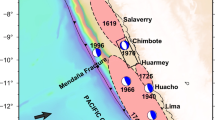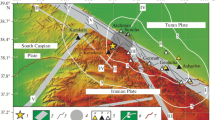Abstract
Based on the geological tectonics, aftershock activity, earthquake surface rupture and peak ground motion, the geometric and dynamic characteristics of seismogenic tectonics about the 1995 Hanshin earthquake are analysed. Nojima fault and Rokko fault have the same trending direction, but opposite dips. Their rising and falling plates are in symmetrically diagonal distribution. The two faults can be defined as thrust-strike slip faults and constitute a pivotal strike-slip fault. The earthquake just occurred at the pivot, which is the seismotectonics for the earthquake to develop and occur. The pivotal movement along a strike-slip fault often leads to the occurrence of large earthquakes, whose dynamic process can be demonstrated by the stress analysis on the torsion of a beam with rectangle section. The displacement of earthquake surface rupture, aftershock density and peak acceleration change in a certain range of epicentral distance just similar as the shear stress changes from the center to the sides in the rectangle section.
The distribution characteristics of the heaviest damage areas are also discussed in the article from the aspects of special geological tectonics and seismotectonic condition. The result obtained from the article can be applied not only to realizing the potencial earthquake sources in middle-long time, but also to build reasonably the prediction model about earthquake hazard.
Similar content being viewed by others
References
Deng, Q. D., 1984. Fault features, basin types and their mechanism.Earthquake Research in China,3, 56–64 (in Chinese).
Deng, Q. D. and Zhang, P. Z., 1985. Rupture mechanism of the Fuyun earthquake fault zone. In:Fuyun Fault Zone, Seismological Bureau of Xinjiang Uygur Automous Region, Beijing: Seismological Publication Press, 105–119 (in Chinese).
Fujita, K., 1979. Judgement criteria for the active periods of active faults in Kinki Region.Earth Monthly,1(8): 583–591 (in Japanese).
Institute of Geology, SSB and Seismological Bureau of Ningxia Hui Autonomous Region, 1990.The Haiyuan Fault Zone, Beining: Seismological publication press, 213–223 (in Chinese).
The Research Group for Active Faults of Japan, 1991.Active Faults in Japan · Sheet maps and inventories, revised edition, Unversity of Tokyo Press (in Japanese).
Toki, K. and Goto, Y., 1995. Characteristics of seismic ground motion, quick report on the great Hanshin · Awaji earthquake,Journal of the Japan Society of Civil Engineering,80, 3 (in Japanese).
United Nations Center for Regional Development (UNCRD), 1995. Report of the January 1995 great Hanshine earthquake (The South Hyogo Prefecture earthquake), UNCRD Discussion Paper,95(2): 2–7.
Zhang, S. C. and Liu, B. C., 1978. Seismological characteristics of Tonghai eathquake in 1970.Scientia Geologica Sinica,4: 323–335 (in Chinese).
Author information
Authors and Affiliations
About this article
Cite this article
Han, ZJ., Ren, FH., Ogawa, Y. et al. Research on the seismotectonics of the January 17, 1995 HanshinM7.2 earthquake. Acta Seismologica Sinica 9, 671–678 (1996). https://doi.org/10.1007/BF02651058
Received:
Revised:
Accepted:
Issue Date:
DOI: https://doi.org/10.1007/BF02651058




